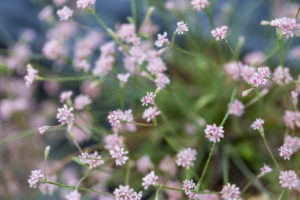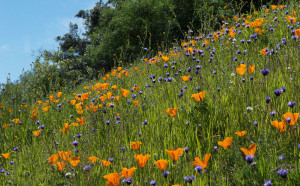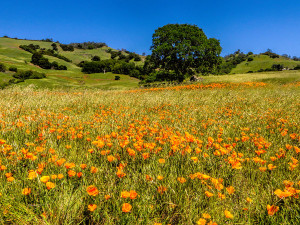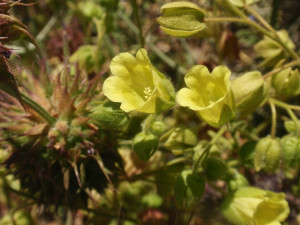The California Consortium of Herbaria houses exactly three dusty Calochortus specimens collected in 1833 by the British naturalist David Douglas (you know him from Douglas fir and Douglas iris). These collection sheets represent some of the oldest herbarium specimens of California flora, from a frontier location Douglas called Nova California. He didn’t record a particularly accurate location for it, but we know now that Calochortus pulchellus, the Mount Diablo fairy lantern, grows only in a narrow range in the East Bay and Solano County, placing Douglas—and his collection—somewhere in the shadow of Mount Diablo. But it would be several decades before the plant even received a formal name. Douglas just saw it, appreciated it, and picked it to chronicle New World wonders.
Even from that 180-year-old specimen you can see why this plant would catch the eye of a roving naturalist. Calochortus is a genus of flowering monocots endowed with large, showy, brightly colored and attractively marked petals and perfect symmetry of color and form. Although these flowers are rarely taller than a foot, they do not fail to attract attention.
Douglas was certainly not the first to set eyes on the beautiful and elegant Calochortus lilies, since native Californians such as the Pomo collected the bulbs from well-recorded and tended sites and cooked them in earth ovens. However, the miniature onion-like bulbs were likely not a favorite food given their small size, their slow growth (it can take five years from seed to flower), and the effort required to excavate them.
Calochortus belongs to the family Liliaceae, commonly known as the lily family, although some researchers yearn to elevate this genus into its own family: Calochortaceae. The name Calochortus is derived from the Greek for “beautiful grass,” which pays homage to its vegetation, best described as long, arching, grass-like leaves that can be spotted even before the late spring-blooming flower is present or in those years when the flower itself does not make an appearance.
But it’s the floral display that catches everyone’s eyes: from the pendant snowy drops of the white fairy lantern (Calochortus albus) to the purplish hirsute petals of Tolmie’s pussy ears (Calochortus tolmiei) to the open golden landing pad adorned with rich burgundy splashes of the yellow mariposa lily (Calochortus luteus), the flowers of this genus regularly inspire awe and cause digital camera cards to fill up quickly. Arguably the most diverse bulb genus in the Western Hemisphere, Calochortus contains many California species that are narrow endemics, growing only in limited areas, and are therefore protected as state or federal rare species.
This high degree of endemism and diversity, some researchers have argued, could be a consequence of the genus’ large seeds, which do not disperse well. Thus, many species became highly adapted to the particular substrates and climatic conditions of the place they evolved. The endangered Tiburon mariposa lily (Calochortus tiburonensis) on Ring Mountain in southern Marin is one example of narrow endemism.
There are 18 species of Calochortus identified in the Bay Area, although hybrids may be found that can stump the best of the taxonomists. The genus can be split into four groups that are all easily discernible: mariposas with open, tulip-like upright floral displays; cat’s ears with smaller displays covered by trichomes (which look like thick hairs); star tulips with spreading, smooth petals; and fairy lanterns with drooping, closed inflorescences.
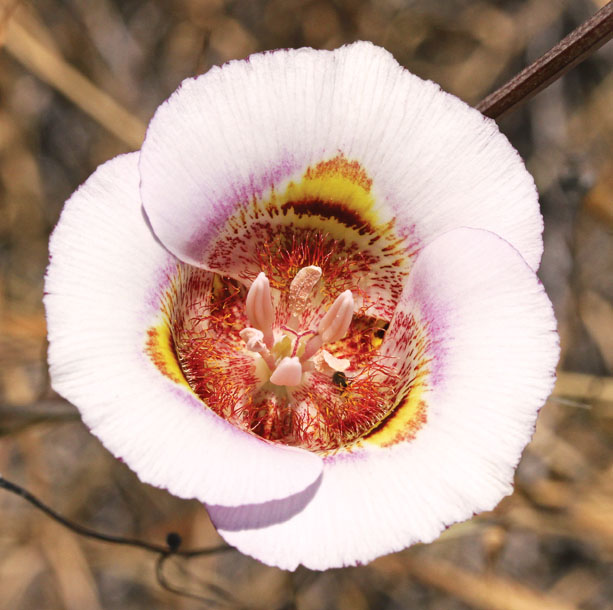
One of the easiest species to locate is the white fairy lantern, which lights up at sunset with the slightest pinkish and golden hues. Well represented in woodlands and scrub habitats, this plant often sits at the edge of vegetation communities, benefiting from both sun and shade. White fairy lanterns are found in all counties south of the Golden Gate and in the Sierra Nevada. The Sneath Lane trail through San Mateo County’s Sweeney Ridge (GGNRA) is one of hundreds of places graced by this plant in the Bay Area.
Pussy ears are another notable beauty, ranging from Canada to the southernmost occurrences in Santa Clara and San Mateo counties, mostly along the coast. This furry cat’s ear lily was once spotted by the godfather of California botany, Willis Linn Jepson, in Gilroy’s Little Arthur Creek, although it likely hasn’t been seen there in more than 100 years. Instead, try the grassy slopes at Point Reyes National Seashore, like those just west of Abbotts Lagoon or atop the bluffs at Chimney Rock.
Of course, the beauty of the floral display isn’t just for human enjoyment. Calochortus attracts a wide variety of insects to its nectar and other parts of the plant. One paper from the journal Oikos in 2000 notes that insect visitors to Calochortus species were observed feeding on pollen, at the glands, on the long hairs, and at the ovary base, while others even used the plant for mating. In fact, it’s not unusual to see two or three species of insect on the same flower, benefiting from its supermarket of resources.
The bugs are a tiny reminder of the splendor of Calochortus, a plant that emerges in the spring as a grass, explodes into a captivating flower, and just as quickly fades away with little trace. These lilies have fed and inspired generations of people and insects alike. See how many you can find this spring. And don’t forget to bring your camera!


